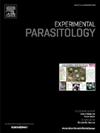Cystic echinococcosis susceptibility is increased by polymorphisms in the transporter associated with antigen processing 1 and 2 genes
IF 1.6
4区 医学
Q3 PARASITOLOGY
引用次数: 0
Abstract
Susceptibility or resistance to various diseases, especially parasitic infections, largely depends on immune system function and genetics. Single nucleotide polymorphisms on the TAP1-637 and TAP2-379 genes may play a role in hydatidosis by affecting the immune system.
This study was conducted as a case-control study. After confirmation by serological ELISA method, blood samples were collected from 76 people with hydatid cyst and also from 76 healthy people. DNA was extracted from the samples and the ARMS-PCR technique was used to identify mutations. To evaluate the accuracy and ensure the PCR results, some samples were also sequenced in two groups with different genotypes.
Compared to the control group, the case group (infected group) had a higher frequency of the heterozygous Asp/Gly codon 637 of the TAP1 gene. In addition, the frequency of the Gly phenotype and allele was higher in the infected group (P < 0.05). Furthermore, the infected group had a higher frequency of the heterozygous Val/Ile codon 379 of the TAP2 gene. The frequency of the Ile phenotype and allele was also higher in the infected group than in the control group (P < 0. 05).
The results of this study showed that the Gly allele and Asp/Gly genotype in codon 637 of the TAP1 gene, as well as the Ile allele and Val/Ile genotype in codon 379 of the TAP2 gene are considered genetic risk factors for cystic echinococcosis.
囊性包虫病的易感性增加与抗原处理1和2基因相关的转运体的多态性
对各种疾病的易感性或抵抗力,特别是寄生虫感染,在很大程度上取决于免疫系统功能和遗传。TAP1-637和TAP2-379基因的单核苷酸多态性可能通过影响免疫系统在包虫病中发挥作用。本研究为病例对照研究。采用血清学ELISA法对76例包虫病患者和76例健康人进行了血液采集。从样本中提取DNA,采用ARMS-PCR技术鉴定突变。为了评估准确性和保证PCR结果,部分样品也被分成两组不同的基因型进行测序。病例组(感染组)出现TAP1基因杂合Asp/Gly密码子637的频率高于对照组。此外,感染组Gly表型和等位基因的频率更高(P <;0.05)。感染组出现TAP2基因杂合Val/Ile密码子379的频率较高。感染组的Ile表型和等位基因频率也高于对照组(P <;0. 05).本研究结果表明,TAP1基因637密码子的Gly等位基因和Asp/Gly基因型,以及TAP2基因379密码子的Ile等位基因和Val/Ile基因型被认为是囊性包虫病的遗传危险因素。
本文章由计算机程序翻译,如有差异,请以英文原文为准。
求助全文
约1分钟内获得全文
求助全文
来源期刊

Experimental parasitology
医学-寄生虫学
CiteScore
3.10
自引率
4.80%
发文量
160
审稿时长
3 months
期刊介绍:
Experimental Parasitology emphasizes modern approaches to parasitology, including molecular biology and immunology. The journal features original research papers on the physiological, metabolic, immunologic, biochemical, nutritional, and chemotherapeutic aspects of parasites and host-parasite relationships.
 求助内容:
求助内容: 应助结果提醒方式:
应助结果提醒方式:


